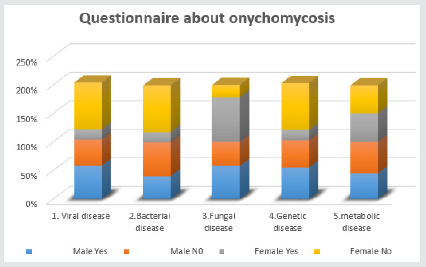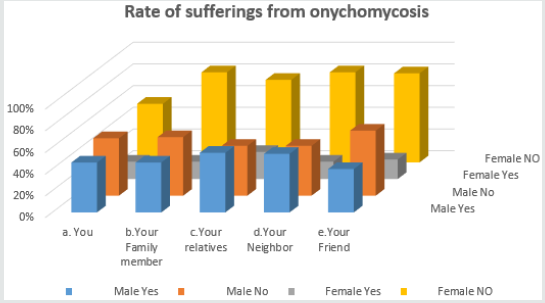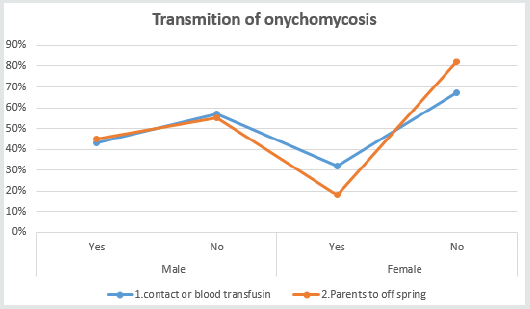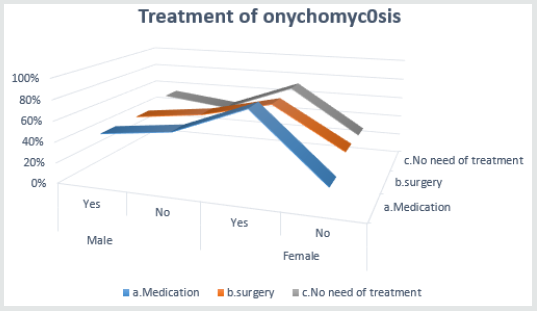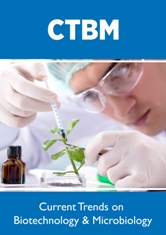
Lupine Publishers Group
Lupine Publishers
Menu
Research Article(ISSN: 2641-6875) 
Perspective of Postgraduate Biology Students About Onychomycosis Volume 1 - Issue 2
Muhammad Imran Qadir and Salma Batool*
- Institute of Molecular Biology and Biotechnology, Multan, Pakistan
Received: January 03, 2019; Published: January 10, 2019
*Corresponding author: Salma Batool, Institute of Molecular Biology and Biotechnology, Multan, Pakistan
DOI: 10.32474/CTBM.2019.01.000107
Abstract
Aim and objective of the current study was the awareness about onychomycosis. The comprehensive of 68 subjects engaged in prevalent study. Subjects were the postgraduate biology students of Bahauddin Zakariya University Multan, Pakistan. We composed the questionnaire and inquire their perspective about onychomycosis. It was completed from the prevalent investigation that onychomycosis was a fungal disease and recessively found among the male individuals.
Keywords: Onychomycosis; Perspective; Blemish; Medication; Dermatophytes
Introduction
Onychomycosis is a fungal contagion of the nail. White or yellow nail blemish or discoloration, thickening or buttress of the nail or segregation of the nail from the nail mattress are the signs of the onychomycosis. The most affected areas of the body are toenails and fingernails. But the toenails are most reported to be affected by this. Onychomycosis or tinea is an infection of nails bed, matrix, or plate. It causes the many types of entanglement including cellulitis of lower legs and causes the plate, stitch, discomfiture etc. Although it is a function but without any pain [1]. This disease can also produce the visible and professional curb and trim the quality of life span. The superficial fungal infection is taken intently as it causes the epidemic health problems such as they produce the fungal stock that can be hand on through shoes and direct union. As a result, it can be transmitted from the toenails to other parts of the body. It occurs in 10% of adult population and is found more in males than in females [2]. Dermatophytes and fusarium are some fungus which the causes of the onychomycosis are. There may be three organisms of the fungal infection which causes the damage to the skin, hair, and nails, and they only feeds on the nails called the dermatophytes, yeast and non-dermatophytes but all these causes the similar and chronic functions. That is why only the visual appearance cannot explain which variety of the infection is caused by the which organism [3]. But the estimate of their infection is that the yeasts are responsible of 8% and non-dermatophytes are for 2%of fungal nail infection. Athlete’s foot and other nail disease are some of the hazard’s situations with the exposure to the peripheral vascular disease and impoverished immune function [4]. To find the reason the toenail to be infected we must know the dermatology of the nail. The place where the nail starts called the nail matrix is where the cell starts to multiply and keratinize before that they incorporated into fingernail or toenail. That matrix of the nail starts under the skin 5mm below the nail fold, and they surround the area called the lunula. The place where the finger or toe conformed to the nail called the cuticle which is adapted skin to blend them [5]. The nail bed is the spongy tissue underneath the nail and is protected by the nail plate and the nail bed anchoring the nail plate. Nail itself is the nail plate. Medication of the fungal nail is difficult due to the slow growth of the nail with a little blood supply. Cure in the past was less effective because of the upper drawbacks, but the recent researches allowing us the number of treatments with the option of oral intake and topical. Topical antifungals are applied to the skin and infected areas to kill the fungus and other pathogens [6].
Newer oral medicines have improved the treatment of fungal nail infection with the rate of cure is high even with a narrower medicine with some of the risks. Its cure is also available through surgery and laser treatment where some of the chemicals are applied to remove the contagious nail. The chemical that is urea compound can remove the thick nail and surgery treatment is not effective without any additional therapy that is why to attain the effective results the combination of oral, topical and surgical are used [7]. Some of the home remedies are also used such as coconut oil, tea tree oil, white vinegar, baking soda, lavender oil, garlic, orange oil but with little data to support it. Unluckily, it is impossible to prevent from getting this infection. But some of the preventive measures are that avoid from barefoot, wash the hand after greeting with the infectious person and use the antifungal spray in gym shoes [8]. Sixteen European countries found to be infected by onychomycosis according to the 2003 survey of disease on foot with prevalence of 27% and it was increased with age. Its prevalence is 6.48% in Canada. One third Diabetic patients are affected by it and 56% in those people which are suffering from psoriasis. The aim and objective of the current study was the awareness about onychomycosis.
Materials and Methods
We made the questionnaire to guestimate awareness about analysis of onychomycosis
a) Do you think onychomycosis is a viral disease?
a) Yes b) No
b) Onychomycosis is a bacterial disease
a) Yes b) No
c) Onychomycosis is a fungal disease
a) Yes b) No
d) Onychomycosis is a genetic disease
a) Yes b) No
e) Onychomycosis is a metabolic disease
a) Yes b) No
f) Had you ever suffered from Onychomycosis?
a) Yes b) No
g) Had your family member ever endure from onychomycosis?
a) Yes b) No
h) Your any relative ever undergoes to onychomycosis
a) Yes b) No
i) Is there any neighbor who is flagging with onychomycosis?
a) Yes b) No
j) Any of your friend go through onychomycosis
a) Yes b) No
k) Do you think that onychomycosis is transmitted through blood transfusion or contact?
a) Yes b) No
l) Can it be transfer from parents to offspring?
a) Yes b) No
m) Is it treated by the medicines?
a) Yes b) No
n) Onychomycosis can be handled by surgery
a) Yes b) No
o) What do you think that there is no need of treatment for onychomycosis?
a) Yes b) No
Statistically Analysis
Numerical investigation (statistical analysis) was fulfilled by adopting MS Excel.
Results and Discussion
Perspective of postgraduate biology students about onychomycosis is given below in graphical representation (Figure 1). The graph above represents that onychomycosis is a fungal disease in views of 78% female and 58% male. 46% and 82% males and females respectively, assumed it not to be a viral bug and 40% males and 18% females took nail coloring as a bacterial stroke [9]. According to the current observation of its nature, 55%males,18%females estimated it to be genetic contagion and 45%amles and 50%females imagined it to be metabolic disorder (Figure 2). This graph illuminated that 46%males,16%females had an infection of onychomycosis and their family member and 55% and 25% their relatives also 54% and 16 % of their neighbors and 40% and 18%of the friends of males and females respectively tainted with onychomycosis [10] (Figure 3). The graph shows that onychomycosis never be transmitted through blood contact according to 43% males and 32%females. It also not be transmitted from parents to offspring in perspective of males and females (Figure 4). These ratios reveal that onychomycosis could be cured through surgery, medication or it had no harmful effect if it remained uncured in a viewpoint of 46%,46%,54%males and 81%,70%,71%females accordingly. Questionnaire based studies have given an important advancement in recent researches. Different numbers of researches have been done on the onychomycosis such as Figures 1.
Conclusion
It was completed from the current inspection that onychomycosis is a fungal disease. Both males and females suffered from it.
References
- Global Onychomycosis Drug Market Research Analysis (2018) Torrent Pharma, J&J, Yangtze River and Chengdu Brilliant, Global Onychomycosis (Tinea Unguium) Drug Market Study 2018-2025: Johnson & Johnson, GSK, Novartis, Pfizer (Eds.) Clinical Diagnostic Accuracy of Onychomycosis: A Multispecialty Comparison Study.
- David G Li, Jeffrey M Cohen, Anar Mikailov, Ramone F Williams, Alvaro C Laga, Onychomycosis: Pathogenesis, Diagnosis, and Management.
- Qadir MI, Javid A (2018) Awareness about Crohn’s Disease in biotechnology students. Glo Adv Res J Med Medical Sci 7(3): 062-064.
- Qadir MI, Saleem A (2018) Awareness about ischemic heart disease in university biotechnology students. Glo Adv Res J Med Medical Sci 7(3): 059-061.
- Qadir MI, Ishfaq S (2018) Awareness about hypertension in biology students. Int J Mod Pharma Res 7(2): 08-10.
- Qadir MI, Mehwish (2018) Awareness about psoriasis disease. Int J Mod Pharma Res 7(2): 17-18.
- Qadir MI, Shahzad R (2018) Awareness about obesity in postgraduate students of biotechnology. Int J Mod Pharma Res 7(2): 14-16.
- Qadir MI, Rizvi M (2018) Awareness about thalassemia in post graduate students. MOJ Lymphology & Phlebology 2(1): 14-16.
- Qadir MI, Ghalia BA (2018) Awareness survey about colorectal cancer in students of M. Phil Biotechnology at Bahauddin Zakariya University, Multan, Pakistan. Nov Appro in Can Study 1(3).
- Qadir MI, Saba G (2018) Awareness about intestinal cancer in university student. Nov Appro in Can Study 1(3).

Top Editors
-

Mark E Smith
Bio chemistry
University of Texas Medical Branch, USA -

Lawrence A Presley
Department of Criminal Justice
Liberty University, USA -

Thomas W Miller
Department of Psychiatry
University of Kentucky, USA -

Gjumrakch Aliev
Department of Medicine
Gally International Biomedical Research & Consulting LLC, USA -

Christopher Bryant
Department of Urbanisation and Agricultural
Montreal university, USA -

Robert William Frare
Oral & Maxillofacial Pathology
New York University, USA -

Rudolph Modesto Navari
Gastroenterology and Hepatology
University of Alabama, UK -

Andrew Hague
Department of Medicine
Universities of Bradford, UK -

George Gregory Buttigieg
Maltese College of Obstetrics and Gynaecology, Europe -

Chen-Hsiung Yeh
Oncology
Circulogene Theranostics, England -
.png)
Emilio Bucio-Carrillo
Radiation Chemistry
National University of Mexico, USA -
.jpg)
Casey J Grenier
Analytical Chemistry
Wentworth Institute of Technology, USA -
Hany Atalah
Minimally Invasive Surgery
Mercer University school of Medicine, USA -

Abu-Hussein Muhamad
Pediatric Dentistry
University of Athens , Greece

The annual scholar awards from Lupine Publishers honor a selected number Read More...













